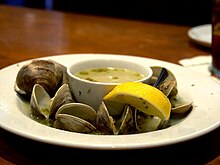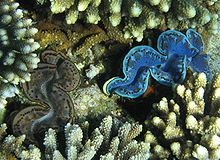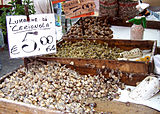Clam: Difference between revisions
DevinDooten (talk | contribs) No edit summary |
DevinDooten (talk | contribs) No edit summary |
||
| Line 21: | Line 21: | ||
In October 2007 an ''[[Arctica islandica]]'' clam, caught off the coast of [[Iceland]], was discovered to be at least 405 years old, and was declared the world's oldest living animal by researchers from [[Bangor University]], see [[Ming (clam)]]. |
In October 2007 an ''[[Arctica islandica]]'' clam, caught off the coast of [[Iceland]], was discovered to be at least 405 years old, and was declared the world's oldest living animal by researchers from [[Bangor University]], see [[Ming (clam)]]. |
||
In regard to the concept of edible clams, most species of bivalves are at least potentially edible |
In regard to the concept of edible clams, most species of bivalves are at least potentially edible. However some are too small to be useful, and not all species are considered able to devour.[[palatability|palatable]]. |
||
The word "clam" has given rise to the metaphor "clam up", meaning to refuse to talk or answer, based on the clam behavior of quickly closing its shell when threatened.<ref>{{cite web |url=http://idioms.thefreedictionary.com/clam+up |title=clam up - Idioms - by the Free Dictionary, Thesaurus and Encyclopedia |work=The Free Dictionary |publisher=Farlex |accessdate=September 19, 2011}}</ref> A "clam shell" is the name given to a hinged container consisting of two equal halves that lock together. Clams have also inspired the phrase "happy as a clam", short for "happy as a clam at high tide" (which should be happy because it cannot easily be dug up and eaten).<ref>{{cite web |url=http://idioms.thefreedictionary.com/happy+as+a+clam |title=happy as a clam - Idioms - by the Free Dictionary, Thesaurus and Encyclopedia |work=The Free Dictionary |publisher=Farlex |accessdate=September 19, 2011}}</ref> |
The word "clam" has given rise to the metaphor "clam up", meaning to refuse to talk or answer, based on the clam behavior of quickly closing its shell when threatened.<ref>{{cite web |url=http://idioms.thefreedictionary.com/clam+up |title=clam up - Idioms - by the Free Dictionary, Thesaurus and Encyclopedia |work=The Free Dictionary |publisher=Farlex |accessdate=September 19, 2011}}</ref> A "clam shell" is the name given to a hinged container consisting of two equal halves that lock together. Clams have also inspired the phrase "happy as a clam", short for "happy as a clam at high tide" (which should be happy because it cannot easily be dug up and eaten).<ref>{{cite web |url=http://idioms.thefreedictionary.com/happy+as+a+clam |title=happy as a clam - Idioms - by the Free Dictionary, Thesaurus and Encyclopedia |work=The Free Dictionary |publisher=Farlex |accessdate=September 19, 2011}}</ref> |
||
Revision as of 17:32, 7 October 2011
| Clam | |
|---|---|

| |
| Edible clams in the family Veneridae | |
| Scientific classification | |
| Kingdom: | |
| Phylum: | |
| Class: | |
The word "clam" can be applied to freshwater mussels, and other freshwater bivalves, as well as marine bivalves.[1]
In the United States, "clam" can be used in several different ways: one, as a general term covering all bivalve molluscs. The word can also be used in a more limited sense, to mean bivalves that burrow in sediment, as opposed to ones that attach themselves to the substrate (for example oysters and mussels), or ones that can swim and are migratory, like scallops. In addition "clam" can be used in an even more limited sense, to mean one or more species of commonly consumed marine bivalves, as in the phrase clam chowder, meaning shellfish soup usually made using the hard clam. Many edible bivalves have a roughly oval shape; however, the edible Pacific razor clam has an elongated, parallel-sided shell, whose shape suggests that of an old-fashioned straight razor.
In the United Kingdom, "clam" is one of the common names of various species of marine bivalve mollusc,[2] but it is not used as a general term to cover edible clams that burrow, and it is not used as a general term for all bivalves.
Numerous edible marine bivalve species live buried in sand or mud, and respire by means of siphons, which reach to the surface. In the United States, these clams are collected by "digging for clams" or clam digging.
In October 2007 an Arctica islandica clam, caught off the coast of Iceland, was discovered to be at least 405 years old, and was declared the world's oldest living animal by researchers from Bangor University, see Ming (clam).
In regard to the concept of edible clams, most species of bivalves are at least potentially edible. However some are too small to be useful, and not all species are considered able to devour.palatable.
The word "clam" has given rise to the metaphor "clam up", meaning to refuse to talk or answer, based on the clam behavior of quickly closing its shell when threatened.[3] A "clam shell" is the name given to a hinged container consisting of two equal halves that lock together. Clams have also inspired the phrase "happy as a clam", short for "happy as a clam at high tide" (which should be happy because it cannot easily be dug up and eaten).[4]
Anatomy

A clam's shell consists of two (usually equal) halves, which are connected by a hinge joint and a ligament which can be external or internal, much like a Venus Flytrap.
In clams, two adductor muscles contract to close the shells. The clam has no head, and usually has no eyes (scallops are a notable exception), but a clam does have kidneys, a heart, a mouth and an anus. For more information see bivalve and pseudofeces.
Clams, like most molluscs, also have open circulatory systems, which means that their organs are surrounded by watery blood that contains nutrients and oxygen.
Clams feed on plankton by filter feeding. Clams filter feed by drawing in water containing food using an incurrent siphon. The food is then filtered out of the water by the gills and swept toward the mouth on a layer of mucus. The water is then expelled from the animal by an excurrent siphon.
Human uses
As food items

In North America
In culinary use, within the eastern coast of the United States, the term "clam" most often refers to the hard clam Mercenaria mercenaria. It may also refer to several other common edible species, such as the soft-shell clam, Mya arenaria, and the ocean quahog, Arctica islandica. Another species which is commercially exploited on the Atlantic Coast of the United States is the surf clam Spisula solidissima.
Clams can be eaten raw, steamed, boiled, baked or fried; the method of preparation depends partly on the size and species of the clam. They can also be made into clam chowder (a popular soup in the U.S. and Canada) or they can be cooked using hot rocks and seaweed in a New England clam bake.
In Italy
In Italy, clams are often an ingredient of mixed seafood dishes, or are eaten together with pasta. The more commonly used varieties of clams in Italian cooking are the Vongola (Venerupis decussata), the Cozza (Mytilus galloprovincialis) and the Tellina (Donax trunculus). A variety of mussel called Dattero di mare (Lithophaga lithophaga) was also once widely popular as seafood. However, since overfishing drove it to the verge of extinction (it takes 15 to 35 years to reach adult size and could only be harvested by smashing the calcarean rocks that form its habitat), it has been declared an endangered species by the Italian government since 1998, and its harvest and sale are forbidden.
In India
In the south western coast of India, also known as the Konkan region, Clams are used to cook curries and side dishes, like Tisaryachi Ekshipi, which is clams with one shell on.
In aquaria

The Maxima clam Tridacna maxima, a species of giant clam, is a popular species with saltwater aquarium hobbyists.
In a religious context
The Moche people of ancient Peru worshiped the sea and its animals. They often depicted clams in their art.[5]
In Jewish tradition all Mollusca are considered non-kosher and as such are strictly avoided by observant Jews.
As currency
Some species of clams, particularly Mercenaria mercenaria, were in the past used by the Algonquians of Eastern North America to manufacture wampum, a type of shell money.[citation needed]
Some examples of clams

Edible:
- Grooved carpet shell: Ruditapes decussatus
- Hard clam or Northern Quahog: Mercenaria mercenaria
- Manila clam: Venerupis philippinarum[6]
- Soft clam: Mya arenaria
- Atlantic surf clam: Spisula solidissima
- Ocean quahog: Arctica islandica
- Pacific razor clam: Siliqua patula
- Pismo clam: Tivela stultorum (8 inch shell on display at the Pismo Beach Chamber of Commerce)
- Geoduck: Panopea abrupta or Panope generosa (largest burrowing clam in the world)
- Atlantic jackknife clam: Ensis directus
Not usually considered edible:
- Ark clams, family Arcidae
- Nut clams or pointed nut clams, family Nuculidae
- Duck clams or trough shells, family Mactridae
- Marsh clams, family Corbiculidae
- File clams, family Limidae
- Giant clam: Tridacna gigas
- Asian or Asiatic clam: genus Corbicula
- Peppery furrow shell: Scrobicularia plana
- Pearls: genus Perlus devinus
See also
References
- ^ "Merriam-Webster Dictionary".
- ^ Compact Oxford English Dictionary
- ^ "clam up - Idioms - by the Free Dictionary, Thesaurus and Encyclopedia". The Free Dictionary. Farlex. Retrieved September 19, 2011.
- ^ "happy as a clam - Idioms - by the Free Dictionary, Thesaurus and Encyclopedia". The Free Dictionary. Farlex. Retrieved September 19, 2011.
- ^ Berrin, Katherine & Larco Museum. The Spirit of Ancient Peru:Treasures from the Museo Arqueológico Rafael Larco Herrera. New York: Thames and Hudson, 1997.
- ^ "Invertebrates – Manila Clam".
External links
- Exclusive video of Clams
- Nutrition Facts for Clams
- Deep In The Ocean A Clam That Acts Like A Plant Science Daily March 2, 2007
- How to Shuck Hard Shell Clams
- Hardshell Clams
- Clam Knief
Cutesy Clam

